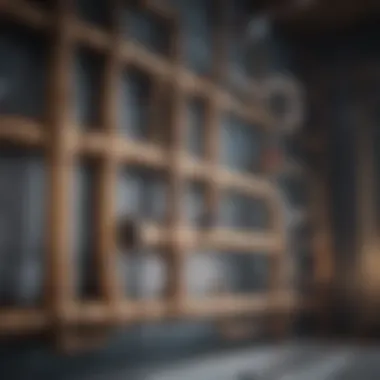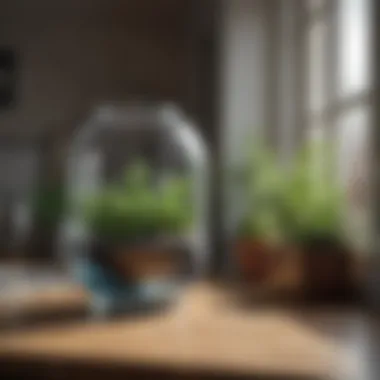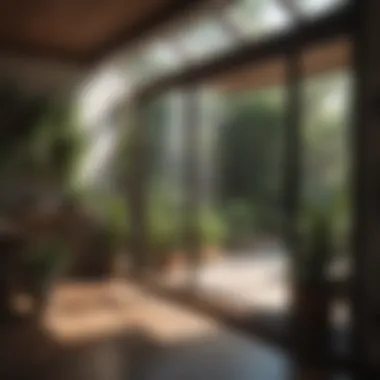Understanding Stale Water Smell in Your Home


Intro
The presence of a stale water smell in your home can be more than just an unpleasant annoyance. It often signals underlying issues in your plumbing, air quality, or even the structure of your home. Understanding this odor is crucial not only for comfort but also for health and safety. Many homeowners may notice these smells but lack the knowledge to address them effectively.
Stale water smells can arise from various sources, ranging from simple unnoticed leaks to intricate plumbing issues. These problems can often escalate if not addressed promptly, leading to further damage and potential health hazards. In this article, we will explore the causes of this odor, the health implications associated with it, and practical solutions to rectify the situation. Homeowners, in particular, must recognize the importance of clean indoor air and the maintenance required to ensure an odor-free living space.
Throughout this guide, we will delve into practical tips on maintenance and care of plumbing systems, while also touching upon budgeting and planning to effectively address and manage these odors. By the end, readers will possess a robust understanding of the factors contributing to stale water smells and actionable strategies to ensure their home remains a pleasant environment.
"Proper maintenance of plumbing systems can prevent many issues, including unwanted odors. A proactive approach is key."
Now let’s begin by closely examining what typically causes stale water smells in a house.
Preamble to Stale Water Smell
Understanding the presence of stale water smell in a house is critical for maintaining a comfortable home environment. This odor may not just be unpleasant; it often indicates underlying plumbing issues that need to be addressed. Homeowners, interior design enthusiasts, and even party hosts must recognize that air quality impacts overall well-being.
Stale water smells can stem from a variety of sources, including stagnant water, poor drainage, or even bacterial growth in pipes. Recognizing these issues early can lead to effective solutions that enhance the quality of indoor air. The benefits of addressing the smell are many. It can lead to a healthier living space, improve the aesthetics of a home, and even increase property value.
In this article, we will explore the causes, health implications, and practical solutions for stale water odors in more detail. By understanding these elements, homeowners can take proactive measures, ensuring a pleasant and healthy living environment.
What is Stale Water Smell?
Stale water smell is a distinct and often unpleasant odor. It’s commonly described as musty or damp. This scent typically arises from water that has remained in place too long without circulation or usage. The decomposition of organic matter, combined with the presence of specific bacteria, usually contributes to this odor.
In many households, the stale water smell is most frequently found in bathrooms, kitchens, and laundry areas, where water collects. It can also emanate from dishwashers or refrigerators, particularly if there is a problem with drainage.
The importance of identifying and addressing this smell cannot be overstated, as neglecting it can lead not only to further plumbing problems but also potential health risks. A consistent approach to maintaining clean water sources is essential to prevent these issues.
Potential Causes of Stale Water Odor
Understanding the potential causes of stale water odor is crucial for homeowners seeking a healthy living environment. This section will explore specific elements that contribute to this unpleasant smell, helping you identify issues before they escalate. Recognizing these causes empowers you to take proactive steps in maintaining your home, ultimately benefiting both your indoor air quality and your overall well-being.
Poor Drainage Systems
A major factor contributing to stale water smell can often be linked to poor drainage systems. When water flow is obstructed or impeded, moisture can accumulate and lead to stagnation. A poorly drained area might result from inadequate grading around the foundation, blocked gutters, or incorrectly installed drainage pipes. This stagnant water can emit odors that permeate your living space.
Regular inspections of your drainage systems ensure there are no blockages or failures. Maintaining adequate drainage not only minimizes bad smells but also protects your property from potential water damage. Homeowners should be vigilant about their exterior drainage, ensuring proper landscaping and functionality of gutters and downspouts.
Clogged Sinks and Toilets


Clogged sinks and toilets are common culprits of stale water odor. When debris builds up in plumbing systems, it can create blockages that trap stagnant water. This water can begin to decay, releasing foul smells into your home. Over time, soap residue, hair, food particles, and other substances can accumulate in sinks and toilets, exacerbating the problem.
To mitigate this issue, regular cleaning of sinks and toilets is essential. Homeowners should consider using natural drain cleaners or enzyme-based solutions. These methods not only eliminate clogs but also reduce odors without harsh chemicals, enhancing the plumbing system’s overall health.
Bacterial Growth in Pipes
Bacterial growth is another significant factor behind stale water smell. Bacteria thrive in moist environments, which makes plumbing systems a natural habitat for them. If water sits in pipes for extended periods, it can lead to bacterial colonization. The result is an odor that can be both unpleasant and potentially harmful.
To address this, routine maintenance of plumbing systems is vital. Flushing pipes frequently and using water softeners can help minimize bacteria growth. In more severe cases, it may be necessary to consult an expert to inspect and clean your plumbing, eliminating biological hazards from your home's water supply.
Stagnant Water in Appliances
Lastly, stagnant water in appliances can also produce stale odors. Dishwashers, refrigerators, and washing machines can hold water that does not drain properly. Over time, this trapped moisture creates an environment suitable for odors to develop. The smell may become particularly noticeable when these appliances are used, contributing to a less pleasant atmosphere in your home.
To prevent this, homeowners should follow manufacturer guidelines for cleaning and maintenance. Regularly running an empty dishwasher with vinegar or cleaning the washing machine can drastically reduce odors. Additionally, ensuring proper drainage for these appliances helps keep water flowing and minimizes stale smells.
Identifying the Source of Stale Water Smell
Identifying the source of stale water smell in a house is a crucial step in mitigating this issue. Understanding where the odor originates allows homeowners to address underlying problems effectively. Ignoring the smell or masking it may lead to further complications, including potential damage to the plumbing system and the growth of harmful bacteria. By focusing on this aspect, homeowners can not only enhance their living environment but also improve indoor air quality.
Conducting a Home Inspection
When dealing with stale water smells, a thorough home inspection should be the first course of action. Homeowners need to methodically check all areas where water is present. This includes examining sinks, toilets, showers, and appliances like dishwashers and washing machines. Consider looking for the following:
- Visible leaks or pooling water. This could indicate stagnant water buildup.
- Condition of the drainage. Ensure that drainage pipes are free from blockages that might cause odors to be trapped.
- Check for any cracks or gaps in tiles that might lead to water accumulation beneath the surface.
Utilizing a flashlight can help in identifying potential issues that are not easily visible. Significant deviation from normal conditions should raise alarms for further inspection.
Using Smell Identification Techniques
Identifying the specific cause of stale water smell can be aided by particular smell identification techniques. Here are useful strategies to consider:
- Narrowing down locations: Start at the source of the smell. Move around the house to observe if the odor intensifies in certain areas. This can indicate where the problem lies.
- Comparative assessment: Compare the smell in each room. Is it stronger in certain spaces? Note any differences in intensity.
- Timing the smell: Some smells might be more pronounced during specific times, such as after using water fixtures. Keeping track of these patterns can aid in identification.
- Consulting family members: Other occupants may have noticed the smell before; they may provide insights about when they first detected it.
"The effective identification of odors often relies on a methodical approach, combining observation with systematic assessments."
By engaging these strategies, homeowners can pinpoint the origins of stale water smells with greater accuracy, paving the way for effective solutions. Understanding the nuances of where these odors come from enhances the chances of resolving the issue efficiently.
Health Implications of Stale Water Smell


A stale water smell in the home is not just an unpleasant olfactory experience; it can also have significant implications for health and well-being. Understanding these implications is essential for homeowners, as it allows them to respond effectively to potential hazards. The indoor environment plays a crucial role in influencing overall health. Poor air quality can exacerbate existing health conditions and contribute to new problems, which makes this topic particularly relevant.
Impact on Indoor Air Quality
Indoor air quality is critical to the health of occupants in a home. Stale water odors often indicate the presence of mold, mildew, or other contaminants in the air. These substances can thrive in damp environments where water is stagnant. The relationship between stagnant water and air quality is direct.
- Mold spores: When water stagnates, mold spores can become airborne, leading to allergic reactions and respiratory issues.
- Volatile organic compounds (VOCs): These substances can also be present in damp areas, worsening air quality.
- Pest attraction: Stagnant water can attract pests, which contribute to further contamination.
Regular assessments of air quality can prevent these issues. Homeowners should monitor for changes in air quality, especially when unusual odors are detected.
Potential Health Risks
The risks associated with stale water smell extend beyond discomfort. Recognizing these potential health effects helps highlight the importance of addressing this problem. Some of the key health risks include:
- Respiratory problems: Prolonged exposure to mold and other pollutants can cause or worsen asthma and allergies.
- Infections: Bacteria and germs can proliferate in standing water. This means that the risk of infections can increase, particularly in vulnerable populations such as infants and the elderly.
- Toxic exposure: Certain types of mold can produce toxins that pose serious health risks. Prolonged exposure can lead to neurological issues and other systemic problems.
- Mental well-being: A home that smells unpleasant can affect mental health. Inadequate air quality can lead to increased stress and anxiety among residents.
"Indoor air quality is a cornerstone for fostering healthful living conditions."
Addressing the stale water smell is thus not only a matter of comfort, but also crucial for promoting a healthy indoor environment. Homeowners should prioritize inspecting and resolving issues related to stale water to protect their health and that of everyone in the household.
Practical Solutions to Eliminate Stale Water Smell
Addressing the issue of stale water smell in your home is crucial for maintaining a healthy living environment. The odor can arise from various sources, many of which are indicators of deeper plumbing and drainage issues. By focusing on practical solutions to eliminate this unpleasant smell, homeowners can take effective steps towards improving indoor air quality and preventing future incidents. The benefits of implementing these solutions extend beyond merely masking odors; they also contribute to the longevity of plumbing systems, enhance comfort, and ensure that the home remains inviting.
Regular Maintenance of Plumbing Systems
A proactive approach is essential for ensuring that plumbing systems function optimally. Regular maintenance involves periodic checks and servicing of pipes, faucets, and drains. Homeowners should schedule inspections at least once a year to look for leaks, corrosion, and other potential issues. Neglect can lead to water stagnation, which promotes bacterial growth and the characteristic stale smell.
Inspecting plumbing fixtures and ensuring that they are in good condition minimizes potential disruptions. Simple actions, such as tightening loose fittings or replacing worn-out gaskets, can go a long way in preventing unwanted odors. Homeowners should also pay attention to less commonly accessed areas, such as basements and crawl spaces, where stagnant water may accumulate unnoticed.
Cleaning and Disinfecting Drains
Cleaning and disinfecting drains is vital in combating stale water smells. Over time, debris, soap scum, and food particles can accumulate, creating an ideal breeding ground for bacteria and odor-causing substances. To combat this, homeowners should establish a regular cleaning schedule.
- Flush with hot water: Pour boiling water down the drains weekly. This helps break down grease and other residues.
- Use vinegar and baking soda: A natural combination, mixing these two ingredients can effectively dissolve buildup. Pour half a cup of baking soda down the drain, followed by half a cup of vinegar. Let it sit for about 30 minutes before rinsing with hot water.
- Consider enzymatic cleaners: These cleaners break down organic matter that may be causing odors without harming plumbing.
By maintaining cleanliness in drainage systems, homeowners can significantly reduce the presence of stale odors and improve overall hygiene.
Proper Use of Appliances


Appliances that use water, such as dishwashers and washing machines, can also contribute to stale water smells if not used and maintained correctly. It's important to follow manufacturers' guidelines for usage to prevent problems.
- Always run full loads: For dishwashers and washing machines, ensure that items are fully loaded before running them. This not only saves water but also helps minimize stagnation.
- Leave doors open: After use, leave the doors of appliances slightly ajar to allow for airflow and dry the interior, preventing moisture buildup.
- Clean appliance filters: Regularly check and clean filters according to the manufacturer's directions. Clogged filters can cause water to sit and become stale, leading to odors.
By understanding how to properly use and maintain household appliances, homeowners can avert the development of stale water smells, ensuring that their living spaces remain fresh and pleasant.
Regular attention to plumbing maintenance, cleaning of drains, and proper use of appliances can have a lasting impact on indoor air quality.
Long-term Strategies for Prevention
Addressing stale water smell in the home requires more than just immediate solutions. Long-term strategies are crucial to maintain a fresh living environment. Implementing these methods can not only eliminate odors but also ensure a healthier home. The benefits are substantial, including improved air quality, better plumbing performance, and potentially lower maintenance costs in the future.
Focusing on prevention allows homeowners to tackle issues before they escalate. A proactive approach helps identify recurring problems and develops strategies to mitigate them effectively.
Implementing Effective Drainage Solutions
Effective drainage is fundamental in preventing stale water odor. Poorly functioning drainage systems can lead to water stagnation, creating an ideal environment for bacteria to thrive. Here are some key elements to consider:
- Regular Inspections: Have plumbing systems inspected regularly. This can help catch leaks or blockages early.
- Install Drain Traps: Using drain traps can significantly reduce odors. They capture debris and prevent clogs.
- Maintain Outdoor Drains: Keep outdoor drainage free of leaves and debris. This ensures smooth water flow and prevents backflow.
- Proper Grading: Ensure that the land surrounding the home is graded away from the foundation. This allows proper drainage and avoids water pooling.
By focusing on these drainage solutions, homeowners can reduce the risk of water accumulation and ongoing odor issues.
Choosing the Right Plumbing Fixtures
Selecting appropriate plumbing fixtures can significantly influence the overall plumbing health of a home. Here are some factors to consider:
- Materials Matter: Copper and PVC pipes are less likely to develop corrosion and leaks compared to other materials. This can minimize odor problems related to pipe deterioration.
- Quality Fixtures: Invest in high-quality faucets and toilets that are less prone to clogging. This reduces stagnant water issues that often lead to foul smells.
- Flow Rate: Choose fixtures and appliances that are designed for optimal flow rates. Underused fixtures can trap stale water, leading to unpleasant odors.
- Regular Cleaning: Ensure that all plumbing fixtures are cleaned regularly. This practice helps to maintain hygiene and reduces the risk of buildup that may cause odors.
In summary, long-term prevention strategies encompass effective drainage solutions and careful selection of plumbing fixtures. Together, these measures enhance plumbing efficiency and ensure a fresher living space.
Ending and Final Recommendations
Recap of Key Points
- Understanding Stale Water Smell: It is crucial to identify what constitutes a stale water smell and to differentiate it from other odors.
- Potential Causes: Poor drainage systems, clogged sinks and toilets, bacterial growth in pipes, and stagnant water in appliances are all common culprits.
- Identifying the Source: Conducting thorough home inspections and utilizing specific smell identification techniques can help in locating the exact source of the odor.
- Health Implications: Stale water smells can negatively impact indoor air quality and may pose health risks, particularly for sensitive individuals.
- Practical Solutions: Regular maintenance of plumbing systems, cleaning drains, and properly using appliances are essential to eliminate the smell.
- Long-term Strategies: Implementing effective drainage solutions and choosing the right plumbing fixtures are proactive steps for prevention.
When to Seek Professional Help
Homeowners should consider seeking professional assistance in the following situations:
- If the stale water smell persists despite DIY efforts to eliminate it.
- When there are visible signs of water damage or mold that could indicate a larger problem.
- If plumbing systems show signs of failure, such as frequent clogs or leaks.
- When diagnosing the cause becomes too complex or time-consuming for a regular homeowner.
Seeking professional help can save time and expense in the long run, ensuring that any hidden issues are identified and resolved effectively.
"Preventive maintenance is often more cost-effective than dealing with emergencies!"
In summary, understanding and addressing the stale water smell in your house enhances both your comfort and health. Following the recommendations in this article can lead to a cleaner, fresher home. By being proactive, you can ensure that your living space remains inviting and healthy.















